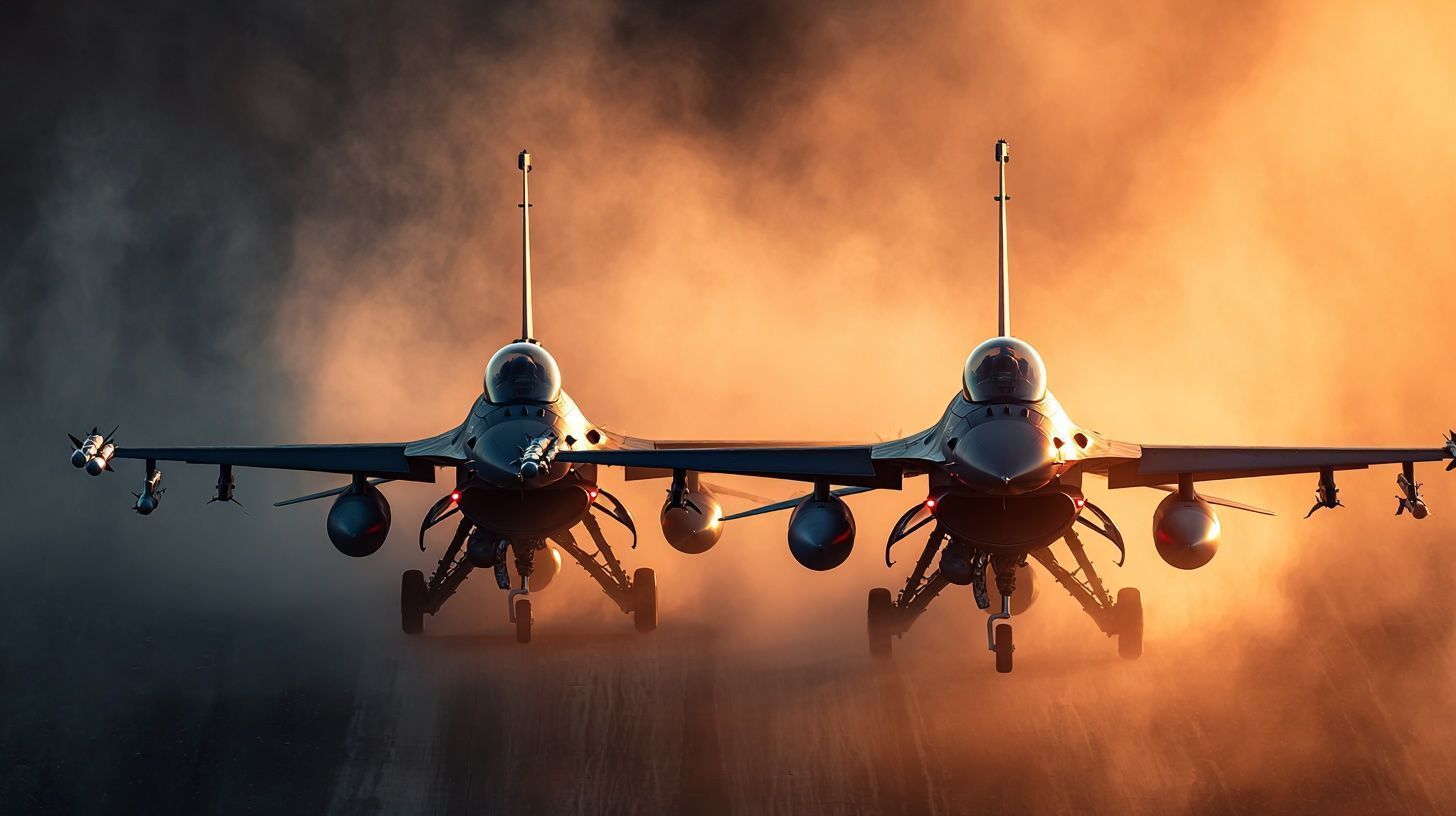- By late 2024, the F-35 Lightning II had surpassed 1,000 deliveries worldwide, fueling Lockheed Martin’s market dominance and its ubiquity across more than a dozen nations.
- Lockheed Martin continues F-16 production into a 50th year with new Block 70/72 variants exported to Slovakia and Bahrain.
- Boeing is delivering the F-15EX Eagle II to the U.S. Air Force, while the F/A-18E/F Super Hornet line ends in 2025 and India’s export bid remains pending.
- Dassault secured a 42-aircraft Rafale F4 tranche in 2023 to be delivered from 2027, with Indonesia also ordering 42 Rafales.
- Saab has 96 firm Gripen E/F orders (60 Sweden, 36 Brazil), and Brazil became the Gripen E’s first export operator in 2022.
- Putin announced an order for 76 Su-57 fighters to be delivered by 2028, though production is constrained by sanctions.
- China’s J-20 Mighty Dragon has about 300 aircraft built by mid-2024, with output near 100 per year, establishing the second-largest stealth fleet after the United States.
- In the Indo-Pacific, Japan operates 147 F-35s and co-develops a sixth-generation fighter with Europe, while Australia has 72 F-35A jets.
- Private adversary-training firms Draken International and Top Aces have assembled fleets of used fighters, including 12 ex-Dutch F-16s for Draken (2021) and 29 ex-Israeli F-16s for Top Aces.
- The global fighter market was about $105.7 billion in 2025, with a backlog of roughly 4,350 firm orders and up to 6,091 including options, and Asia-Pacific is the largest regional market.
Introduction: The global fighter jet market is in takeoff mode in 2025, reaching record heights as nations race to modernize their air forces. Defense giants are vying to supply cutting-edge stealth aircraft amid rising geopolitical tensions and increased military spending. Major powers and their allies are pouring billions into new fighters, driven by NATO’s expansion, the U.S.–China rivalry, the Ukraine war, and Indo-Pacific security concerns. In this report, we delve into the key industry players, procurement trends (including a growing private sector role), breakthrough technologies (stealth, AI, hypersonics, and advanced materials), geopolitical drivers, market size forecasts through the late 2020s, and regional insights spanning North America, Europe, Asia-Pacific, the Middle East, and Latin America. The fighter jet arms race is accelerating – and it’s reshaping both the defense industry and global power balances.
Key Global Players in the Fighter Jet Industry
An F-35A Lightning II of the U.S. Air Force. The F-35 program has surpassed 1,000 deliveries worldwide, exemplifying the advanced stealth fighters fueling market growth [1]. Key Global Players: The fighter jet industry is dominated by a handful of aerospace manufacturers from the United States, Europe, Russia, and China. These companies produce the world’s leading combat aircraft and are capturing the bulk of new orders in 2025:
- Lockheed Martin (USA) – Maker of the F-35 Lightning II and F-16 Fighting Falcon, Lockheed Martin leads the market. The F-35 in particular dominates global fighter procurement, with deliveries passing the 1,000-unit mark by late 2024 [2]. This fifth-generation stealth jet is on order by over a dozen countries, driving Lockheed’s growth. Notably, the venerable F-16 remains in production 50 years after its first flight [3], catering to export customers with new Block 70/72 variants. Lockheed is estimated to hold a very large share of the global fighter market (over 50% by some measures), thanks to the F-35’s ubiquity and ongoing F-16 sales.
- Boeing (USA) – Producer of the F-15 and F/A-18 families, Boeing remains a key player but faces stiff competition from newer designs. It is manufacturing the F-15EX Eagle II for the U.S. Air Force and partners, and until recently built the F/A-18E/F Super Hornet for the U.S. Navy and export. Boeing’s legacy fighters are highly capable (upgraded F-15s and Super Hornets feature advanced radars and weapons), but the company has no fifth-gen stealth fighter in production. The Super Hornet line is slated to shut down by 2025 as the Navy’s last orders are delivered [4], after which Boeing will pivot resources to the T-7 trainer, F-15EX, and future programs. Boeing is investing in next-generation combat aircraft development, aiming to remain competitive for the U.S. Air Force’s sixth-generation fighter bids.
- Dassault Aviation (France) – Manufacturer of the Rafale multirole fighter, Dassault has seen a resurgence with export sales. The Rafale – a 4.5-generation jet known for its versatility and advanced avionics – secured major deals in recent years (India, Qatar, Egypt, etc.). In 2023, France signed a new Tranche 5 contract for 42 Rafale F4 variants to be delivered from 2027 [5], ensuring domestic production for years to come. Export momentum continues: Indonesia finalized an order for 42 Rafales (in a three-phase procurement) [6], and additional sales are likely in the Middle East and possibly India (which already operates 36 Rafales). Dassault’s fighter backlog and pipeline remain strong, and it is also partnering with Airbus on Europe’s Future Combat Air System (FCAS) 6th-gen fighter project.
- Saab AB (Sweden) – Saab produces the JAS 39 Gripen, a lightweight multirole fighter. The latest Gripen E/F variant has attracted interest as a cost-effective yet advanced platform. Saab currently has 96 firm orders for Gripen E/F (60 for Sweden’s air force and 36 for Brazil) [7], with production underway in both countries. Brazil became the first export operator of the Gripen E (designated F-39E) in 2022, ahead of even Sweden, showcasing Saab’s partnership model. The Gripen features modern AESA radar, IRST and electronic warfare capabilities, though it lacks stealth. While Saab’s market share is modest, it is targeting new customers (e.g. Thailand has signaled preference for Gripen E over new F-16s [8]) and touting advantages like lower operating costs and the recent AI-driven trials on a Gripen E (where an AI “wingman” system was tested in flight) [9]. Saab is also focusing on future unmanned combat air vehicles and remains an innovative niche player.
- Sukhoi (United Aircraft Corp, Russia) – Sukhoi designs Russia’s top fighters, including the Su-27/30/35 “Flanker” family and the newer Su-57 Felon stealth fighter. The Flanker series (Su-30MK, Su-35, etc.) has been widely exported and forms the backbone of Russia’s and China’s heavy fighter fleets. However, Russia’s fifth-gen Su-57 program has been slow; only a handful are in service as of 2025. President Putin announced an order for 76 Su-57 fighters to be delivered by 2028 [10], aiming to equip three regiments. Sanctions and resource constraints (exacerbated by the Ukraine conflict) have limited Russia’s production capacity and export prospects – for example, a potential Su-35 sale to Iran is in discussion, but broader exports of Su-57 remain aspirational. Sukhoi (under UAC) is also developing a lighter fifth-gen design (the Checkmate/Su-75 prototype), though its future is uncertain. In the global market, Russian fighters face growing competition as more countries opt for Western or indigenous jets, but they retain some market share in countries that rely on Russian defense equipment.
- Chengdu Aerospace Corp (China) – Chengdu, part of AVIC, produces China’s newest fighters including the J-20 “Mighty Dragon” stealth fighter and the J-10 series. The J-20 is China’s first fifth-generation fighter, now in squadron service with the PLAAF. Production has rapidly accelerated – by mid-2024 an estimated 300 J-20s may have been built, with output approaching 100 per year [11] – giving China the world’s second-largest stealth fighter fleet after the U.S. The J-20’s capabilities (stealth shaping, advanced sensors, supercruise) are continually improving with new engines and avionics. Chengdu also co-developed the JF-17 Thunder (with Pakistan Aeronautical Complex) for export to Pakistan, Nigeria, Myanmar and others as an affordable light fighter. Another Chinese manufacturer, Shenyang, is responsible for the carrier-based J-15 and developing the J-35 stealth fighter; however, Chengdu’s J-20 remains China’s marquee program. While China does not openly export the J-20, its presence influences regional buyers – spurring neighbors to acquire F-35s or upgrade fleets. Chengdu’s success underpins Asia-Pacific’s growth as the largest fighter market, and China is now eyeing a sixth-generation “J-X” program for the 2030s [12] [13].
Table 1: Major Fighter Jet Manufacturers and Programs (2025)
| Manufacturer (Country) | Key Fighter Jets | Notable Recent Developments/Orders |
|---|---|---|
| Lockheed Martin (USA) | F-35 Lightning II (5th-gen stealth); F-16 Fighting Falcon | F-35 surpassed 1,000 deliveries [14]; huge backlog (~2,049 more possible orders) [15]. F-16 still in production after 50 years [16], with new Block 70 exports (e.g. Slovakia, Bahrain). |
| Boeing (USA) | F-15EX Eagle II; F/A-18E/F Super Hornet; EA-18G Growler | Delivering F-15EX to USAF (144 planned) and F-15QA to Qatar. Super Hornet line ending by 2025 [17]; final U.S. Navy order delivered and India export bid pending (if India buys, line stays open to 2027). Boeing refocusing on next-gen fighter development and advanced trainer (T-7) programs. |
| Dassault Aviation (France) | Rafale (4.5-gen multirole fighter) | New French order for 42 Rafale F4 fighters in 2023 [18] ensures production into late 2020s. Strong exports: e.g. 42 Rafales for Indonesia (signed 2021–2022) [19], plus deliveries ongoing to India, Qatar, Egypt, Greece. Developing a Future Combat Air System (FCAS) with partners for a 6th-gen fighter by 2040. |
| Saab AB (Sweden) | JAS 39E/F Gripen (light multirole) | 96 Gripen E/F on order (60 Sweden, 36 Brazil) [20]; Brazil received first F-39E Gripens in 2022. Proposed for new deals (Colombia, Thailand, Philippines). Tested AI-driven combat autonomy on Gripen E in 2025 [21], positioning for future “loyal wingman” roles. |
| Sukhoi / UAC (Russia) | Su-30/35 Flanker family (4++ gen); Su-57 Felon (5th-gen) | Continuing Su-35/Su-30 production for Russian forces and limited export (e.g. Su-35 to China in 2010s). Su-57 stealth fighter in early service; 76 units planned by 2028 [22], though actual annual output is low. Russia’s fighter exportability hampered by sanctions and competition; developing a new light stealth jet (“Checkmate”) targeting foreign buyers by late 2020s. |
| Chengdu / AVIC (China) | J-20 Mighty Dragon (5th-gen stealth); J-10C Firebird (4.5-gen); JF-17 Thunder (with Pakistan) | J-20 fleet expanding rapidly – ~200+ built by end of 2023, possibly ~300 by 2024 [23]. J-20 now deployed in multiple squadrons, with upgraded J-20A variant (new engines) in testing. J-10C equips China and Pakistan (exported as “Dragon” to Pakistan). JF-17 (co-produced) seeing small exports (Africa, Asia). China’s fighter industry growth makes Asia-Pacific the largest regional market [24]. A sixth-gen Chinese fighter program is in development for the 2030s. |
Major Procurement Trends (Military and Private Sector)
The fighter aircraft procurement landscape in 2025 is defined by robust military modernization and some emerging private-sector initiatives. Key trends include:
- Global rearmament and 5th-generation adoption: Many air forces are ramping up fighter acquisitions in response to security threats. The trend is toward stealthy, multirole 5th-generation jets. For example, across NATO and allies, the F-35 is the fighter of choice – recently, Greece secured U.S. approval to buy 40 F-35As (20 firm + 20 options) [25], Finland and Poland have large F-35 orders underway, and additional European states are joining the F-35 program. Similarly, Japan and South Korea are deploying F-35s, and even Middle Eastern countries (like the UAE) have sought the F-35. This widespread adoption of advanced fighters is driving a replacement of 4th-generation fleets on a global scale. At the same time, countries like India and Turkey are launching indigenous fifth-gen projects (e.g. AMCA and TF-X) to join the trend.
- Retirements of aging Cold War jets: As new fighters enter service, older models are being phased out. Many countries are accelerating the retirement of legacy aircraft like 1970s-era MiGs and Mirages. For instance, the Indian Air Force dramatically cut its MiG-21 fleet from 127 to just 36 aircraft in 2023-24 [26]. Eastern European NATO members have retired Soviet-era fighters (e.g. Poland and Slovakia retired MiG-29s, donating some to Ukraine) and are buying modern Western jets in their place. These procurement cycles – replacing MiG-21/23/29, F-4 Phantoms, F-5s, etc. with newer 4.5/5th-gen planes – are a major source of demand. Even the U.S. is divesting older types (F-15C/D, A-10 in the near future) to make room for F-35s and future stealth aircraft. This turnover is boosting new jet orders and also fueling a second-hand fighter market (e.g. Croatia buying used Rafales, Argentina acquiring 24 second-hand F-16s from Denmark [27]).
- Proliferation of light fighters and trainers: Not every mission requires a top-tier stealth jet – many countries are investing in lower-cost fighters, advanced trainers, or light attack jets to complement high-end fleets. There is strong demand for platforms like the Korean FA-50 Fighting Eagle, Italy’s M-346 FA, and the joint Pakistan/China JF-17, which provide modern capabilities at a fraction of the cost of an F-35. For example, Azerbaijan ordered 12 JF-17s in 2023 [28], and countries like the Philippines and Malaysia have ordered FA-50s for light combat roles. Similarly, advanced trainer jets (with light attack capability) are selling well, as air forces prepare the next generation of pilots – recent deals include Nigeria’s order of 24 M-346FA light attack/trainers and multiple nations buying Super Tucano turboprops for counterinsurgency. These “high-low mix” procurement strategies are a notable trend: wealthy air forces pair stealth fighters with cheaper jets for secondary tasks, while smaller nations that cannot afford $100M+ fighters opt for capable light fighters to secure their skies.
- Private sector aggressor fleets: A recent development is the rise of private companies operating fighter jets to provide adversary training and other services to militaries. Firms like Draken International and Top Aces have assembled fleets of used fighter aircraft (such as A-4 Skyhawks, Dassault Falcons, and F-16s) to act as mock enemies in war games. In 2021, Draken – one of the world’s largest private tactical jet operators – acquired 12 ex-Dutch F-16s with an option for 28 more (potentially 40 F-16s total) [29] to augment its “red air” adversary fleet. Top Aces had earlier bought 29 ex-Israeli F-16s [30]. These private “air forces for hire” reflect militaries outsourcing some training; the U.S. Air Force, for example, has a “mammoth adversary air” contract fueling this demand [31]. Moreover, wealthy individuals and defense firms have occasionally purchased demilitarized fighter jets for research or recreation, though this remains niche. Overall, the private sector’s role in the fighter domain is still limited but growing – primarily in training support and aggressor simulation, which frees up frontline military jets for other duties.
- Multi-national procurement programs and industrial partnerships: Another procurement trend is the pooling of resources and co-development among allies. Examples include the Eurofighter Typhoon program (four-nation partnership) and the new collaborations on sixth-generation fighters: Britain, Japan, and Italy merging their efforts into the GCAP (Global Combat Air Programme) for a future fighter, while France, Germany, and Spain cooperate on FCAS. These partnerships aim to share R&D costs and ensure interoperability. Likewise, smaller nations are banding together for purchases (the joint Nordic tender for future jet trainers, for instance). Such cooperative procurement efforts are shaping the market by creating consortiums rather than single-nation buys, leading to larger combined orders and standardized fleets across friendly nations.
Cutting-Edge Technological Advancements in Fighters
Modern fighter jets are at the forefront of aerospace technology. Several key technological advancements are defining current and next-generation fighters:
- Stealth and Low Observability:Stealth technology has become almost a prerequisite for new flagship fighters. Stealth shaping and radar-absorbing materials dramatically reduce an aircraft’s radar cross-section, making it harder to detect. The F-35, Chinese J-20, and Russian Su-57 all incorporate stealth designs, and upcoming sixth-generation programs will push this further (with tailless airframes, internal weapons carriage, etc.). Stealth allows fighters to penetrate advanced air defenses, giving a huge tactical edge. The emphasis on low observability is evident as even 4.5-gen fighters get radar-reducing upgrades (e.g. coating on Rafale, conformal fuel tanks on F-15EX to lower radar returns). Stealth technology is a major market driver – analysts identify it as a top trend shaping new fighter development [32]. We can expect continuous improvements in stealth materials (e.g. metamaterials, plasma reduction techniques) and counter-stealth sensors in a measure-countermeasure cycle.
- Artificial Intelligence & Autonomy: Fighters are increasingly integrating AI and autonomous systems to aid (or even replace) human pilots in certain tasks. AI-enabled “loyal wingman” drones are in development to fly alongside manned fighters, performing scouting or absorbing enemy fire. Inside the cockpit, AI-based decision aids and automation can vastly improve response times and reduce pilot workload. A landmark event occurred in 2025 when Saab tested an AI co-pilot system (Helsing’s “Centaur” AI) on a Gripen E fighter in beyond-visual-range engagements [33] [34]. In those trials, the AI flew the jet and engaged a sparring partner, demonstrating that AI can tactically maneuver a fighter and cue shots. This doesn’t mean Top Gun’s fighter pilots are obsolete, but it shows how AI can act as a co-pilot or wingman to enhance performance. The U.S. Air Force’s Skyborg program and similar projects aim to field AI-driven combat drones as force multipliers. By the late 2020s, it’s likely fighters will routinely operate with autonomous drone teammates, and onboard AI will handle sensor fusion, electronic warfare, and possibly even make split-second firing decisions (with human oversight). The software-defined fighter is a reality – companies are designing fighters with open-architecture avionics that allow rapid AI updates and integration of third-party algorithms [35] [36]. This digital revolution is as important as any hardware upgrade.
- Hypersonic Capabilities and High Speed: While current fighters typically top out around Mach 2–2.5, there is a push for hypersonic capabilities – primarily in terms of weapons. Hypersonic missiles (Mach 5+ speed) launched from fighters can drastically reduce an adversary’s reaction time. Russia has already used the air-launched Kh-47M2 Kinzhal (claimed hypersonic) from MiG-31 interceptors. The U.S., China, and others are developing hypersonic air-to-ground and anti-air missiles that fighters could carry in the future. As for the aircraft themselves, true hypersonic fighter jets are not yet feasible (due to heat and material limits), but next-gen engines (like combined cycle or advanced scramjets) are being researched. At minimum, sixth-gen fighters will likely supercruise (sustain supersonic flight without afterburner) at higher Mach than predecessors, possibly Mach 3+. Speed and altitude remain life-or-death advantages in air combat, and designers are exploring new engine technologies and high-temperature materials accordingly. Industry reports highlight “supersonic and hypersonic technologies” as a significant trend in coming fighter development [37]. We may see hybrid propulsion fighters or adjunct drones that can reach hypersonic velocities within the next decade, particularly for roles like interception of enemy missiles or ultra-fast reconnaissance.
- Next-Gen Materials, Sensors and Avionics: Advances in composite materials and manufacturing are enabling lighter, stronger airframes and internal structures in fighters. Carbon fiber composites, radar-absorbing coatings, and even 3D-printed metal parts contribute to improved performance and easier maintenance. For example, the F-35 and Rafale make extensive use of composites, and future jets will likely incorporate adaptive engine inlets and morphing surfaces made possible by new materials. On the sensor front, AESA (Active Electronically Scanned Array) radars are now standard – they offer far better range, resolution, and jam-resistance than older mechanically scanned radars. Many fighters are getting upgraded AESA radars (e.g. Eurofighter Typhoon’s upcoming ECRS Mk2 AESA upgrade was just funded in 2025 [38]). Sensor fusion – combining radar, IR, and other sensor data via AI – gives pilots unprecedented situational awareness. Networking and data-links are also crucial: modern fighters act as nodes in a combat cloud, sharing targeting data with other jets, AWACS, and ground systems in real-time. The F-35 pioneered this with its Multifunction Advanced Datalink, and new standards like NATO’s Link 16 and MADL integration make coalition operations seamless. Cockpit technology is evolving too (large panoramic touch-screen displays, augmented reality helmets like the F-35’s). Importantly, unmanned combat aerial vehicles (UCAVs) and drones are becoming part of the fighter ecosystem – e.g. France’s Neuron UCAV and Britain’s Mosquito loyal wingman are testbeds for integrating AI-controlled craft with manned fighters. Overall, the major trends in fighter tech can be summarized as stealth, unmanned systems, advanced sensors/avionics, and hypersonic/speed breakthroughs [39] – all underpinned by leaps in computing and materials science.
Geopolitical Influences on Fighter Jet Demand
Geopolitics heavily shapes the fighter jet market, as military aviation procurements respond directly to perceived threats and strategic needs. In 2025, several geopolitical factors stand out:
A formation of NATO fighter jets during an alliance exercise. NATO nations are bolstering their fleets to counter Russian aggression [40], especially after recent eastern expansions.
- NATO Expansion and European Rearmament: The expansion of NATO and renewed tension with Russia have led to a fighter procurement boom in Europe. In 2024, NATO grew to 32 members with the addition of Finland and Sweden [41] – nations that bring advanced air forces and also require integration with NATO systems. Finland, for example, promptly ordered 64 F-35As to replace its F/A-18s in a $9+ billion deal, significantly boosting NATO’s combined airpower on Russia’s border. Eastern flank countries (Poland, Romania, the Baltic states) are investing heavily in fighters to deter any aggression. Poland is buying 32 F-35s and also 48 FA-50 light fighters from South Korea, while Romania is acquiring F-16s to replace old MiGs. Even traditionally neutral or lower-spending countries in Europe are now upping budgets – Germany reversed its stance and decided to buy 35 F-35As to replace Tornado bombers, Belgium and Denmark are acquiring F-35s, and the Netherlands is increasing its F-35 fleet. Defense spending in NATO Europe has surged since 2022; 23 NATO countries now meet or exceed the 2% GDP defense spending target [42] (a number expected to rise). This infusion of funds is largely going into airpower modernization. European nations are not only buying U.S. fighters but also collaborating on new jets (the UK/Italy/Japan GCAP and the Franco-German-Spanish FCAS) to ensure future sovereignty. The Ukraine war has been a wake-up call driving this trend (see below), as European air forces seek both quantity and quality in their combat aircraft to ensure credible deterrence.
- Russia’s War in Ukraine and Its Ripple Effects: The ongoing conflict in Ukraine (since 2022) has had profound effects on the fighter market. First, it has decimated parts of the Russian and Ukrainian air fleets, creating future replacement needs. Ukraine’s air force suffered losses and will need a complete rebuild with Western aircraft – a process that has begun with NATO countries pledging nearly 100 second-hand F-16s to Ukraine [43]. This represents a unique case of large-scale third-party transfer of fighter jets as military aid. Meanwhile, Russia has reportedly lost many aircraft to combat and accidents, straining its industry to replenish them under sanctions. Second, the war spurred European countries to buy new fighters for themselves, as mentioned above. Countries close to Russia feel the urgency to upgrade air defenses – for instance, Finland and Poland’s purchases or Norway accelerating F-35 deployment. There’s also a drive for interoperability with U.S. and NATO systems, given the high coordination seen in aiding Ukraine. The war has showcased the value of air superiority: Russia’s inability to dominate Ukrainian airspace highlighted weaknesses in its air force and the potency of modern SAMs, influencing how countries plan their future fighter mixes (e.g. more stealth, more stand-off weapons). Geopolitically, Russia’s isolation means it must lean on domestic demand (or a few partners like Iran or Syria) for its fighter industry; conversely, Western fighter producers have seen boosted orders from NATO allies worried about Russia. Additionally, the conflict has driven R&D in drones and attritable unmanned aircraft, which intersect with fighter operations. In summary, the Ukraine war has injected urgency (and money) into the European fighter market and altered threat perceptions globally, indirectly benefiting fighter manufacturers from the U.S. and Europe.
- U.S.–China Strategic Rivalry: The rising rivalry between the United States and China is a central driver of fighter procurements in both nations and their spheres of influence. In Asia, China’s aggressive military modernization – especially the rapid expansion of the PLA Air Force with advanced J-20 stealth fighters and a growing arsenal of missiles – has alarmed the U.S. and regional powers. Taiwan is a particular flashpoint: Chinese warplanes make frequent incursions near Taiwan’s airspace (almost daily), as Beijing seeks to wear down Taiwan’s aging fighter fleet [44]. This has prompted the U.S. to approve new F-16V Block 70 sales to Taiwan and to station its own advanced fighters in the Indo-Pacific. America’s strategy to “pivot to the Pacific” has led to deploying Marine F-35Bs in Japan, rotating F-22s and F-35s through Guam and Australia, and investing in next-gen capabilities optimized for a China scenario (like stealth bombers and networking). For its part, China’s J-20 and other fighters are meant to contest air superiority against U.S. and allied air forces in any regional conflict. U.S. allies such as Japan, South Korea, and Australia are responding by buying more fighters and upgrading fleets: Japan is acquiring 147 F-35s (the largest F-35 operator outside the U.S.) and co-developing a sixth-gen fighter with Europe; South Korea is developing the KF-21 and considering F-35B for its carriers; Australia has 72 F-35As and may order more, and is deeply integrating with U.S. forces under agreements like AUKUS. Additionally, India – while not a U.S. ally, is a counterweight to China – is pursuing 4.5-gen Rafales and indigenous fighters due to border clashes with China. In short, the Indo-Pacific arms race is real: China’s military rise is prompting a counter-balancing through advanced fighter acquisitions across the region. The U.S.–China rivalry is pushing the envelope technologically as well, with both investing in 6th-generation fighters and AI-enabled combat drones to ensure an edge. This dynamic will likely dominate fighter market demand through the 2030s, with Asia-Pacific remaining the largest regional market [45] and North America refocusing its procurement (the U.S. Air Force is divesting older jets to free up funds for its secretive Next Generation Air Dominance (NGAD) fighter aimed squarely at outclassing Chinese jets).
- Indo-Pacific Strategies and Alliances: Beyond the U.S.-China bilateral competition, a broader Indo-Pacific security network is influencing fighter buys. Alliances and partnerships – such as the Quad (U.S., India, Japan, Australia) and treaties with Southeast Asian nations – are encouraging interoperability and capability building. For example, Australia, the UK, and the U.S. (AUKUS) are mainly collaborating on submarines, but this partnership reflects a wider trend of intelligence sharing and could extend to cooperative air exercises and technology (Australia might join UK’s Tempest/GCAP fighter development later). Japan and South Korea are increasing defense cooperation with NATO and Western suppliers: Japan’s F-X sixth-gen fighter is now merged with Britain’s Tempest as a joint project (GCAP), bringing together advanced tech from multiple countries. South Korea’s KAI KF-21 “Boramae” fighter – developed with Indonesian participation – had its first flight in 2022 and will enter production later this decade, giving another Indo-Pacific nation its own fighter industry foothold. Meanwhile, countries in the South China Sea region (Indonesia, Malaysia, the Philippines, Vietnam) are modernizing their fighter fleets in light of Chinese assertiveness. The Philippines ordered FA-50s and is considering bigger fighters; Indonesia is buying Rafales and also expressed intent to eventually get the KF-21. Even smaller countries like Bangladesh and Vietnam are evaluating new fighters (reports suggest Bangladesh might buy MiG-35 or light fighters, Vietnam eyeing either Russian or Western jets as it diversifies arms sources). The Indo-Pacific is now a major growth market for fighter aircraft, second only to Europe in growth rate. The U.S. is encouraging this via Foreign Military Sales – for instance, offering India F-21 (an F-16 variant) and F/A-18s, or approving quality-of-life upgrades for allies’ jets. In sum, Indo-Pacific geopolitical strategies – building regional coalitions to contain influence of China and even Russia – are translating into robust fighter procurement plans, from high-end stealth jets to affordable light fighters, across a diverse set of nations.
- Middle East Power Plays: The Middle East has long been a lucrative fighter market, and geopolitical rivalries there remain intense. Gulf Arab states (led by Saudi Arabia and the UAE) continue to buy advanced fighters to counter Iran and bolster their prestige. The UAE made headlines with a record deal for 80 Rafale F4 fighters in 2021 [46] – a $19 billion agreement that was the largest-ever export sale for Dassault. This came after the UAE’s proposed F-35 deal with the U.S. was stalled; the Rafale buy ensures the Emirates field a top-tier fighter regardless. Similarly, Qatar recently completed delivery of 36 Rafales and 36 Eurofighter Typhoons, diversifying its fleet, and has F-15QAs from Boeing arriving. Saudi Arabia operates one of the region’s biggest fleets (F-15SA, Eurofighters, Tornados) and is likely to upgrade or replace older models soon (a potential Typhoon tranche 3 or even a future stealth fighter interest). Israel, while not a buyer in the open market (it receives U.S. aid for F-35s and F-15s), influences the regional balance by fielding the most technologically advanced jets (it was the first in the Middle East with F-35I Adir stealth fighters and is upgrading F-15s). Israel’s qualitative edge drives neighbors to seek better hardware. Iran, under embargo for decades, has relied on aging F-14s and MiG-29s; after the UN arms embargo lapsed in 2020, Iran has moved to acquire new fighters – likely Sukhoi Su-35s from Russia (reports say 24 Su-35s could be delivered to Iran as a quid pro quo for drone aid to Russia). If that happens, Iran would significantly boost its air capabilities, alarming the Gulf states and possibly spurring an arms counter-response. Meanwhile, Turkey (straddling NATO and the Middle East) is a special case: after being removed from the F-35 program due to buying Russian S-400 defenses, Turkey is upgrading its F-16s and pursuing a homegrown 5th-gen fighter (the TF-X “Kaan” which made a taxi test in 2023). Turkey’s regional ambitions and unique position mean it could become a fighter exporter by late 2020s (to Muslim-majority nations that see it as an alternative to Western suppliers). Overall, Middle Eastern geopolitics – Sunni Arab states vs. Iran, intra-Gulf rivalries, Israel’s security, and great power influence – continue to drive high-end fighter jet purchases. This region’s market is characterized by big-ticket deals (often directly between governments) and will remain important for Western manufacturers, as evidenced by the Rafale’s success and ongoing U.S. efforts to sell F-35s or F-15s in the Gulf when political conditions allow.
Market Size and Financial Forecasts Through the Late 2020s
The fighter jet market is experiencing robust growth in the mid-2020s, with significant financial outlays projected through the decade. Annual global spending on fighter aircraft – including new production, upgrades, and related R&D – is on an upward trajectory:
- Current market size: Estimates of the global fighter aircraft market in 2024–2025 range from around $50 billion to over $100 billion per year, depending on definitions. According to one analysis, the market was $97.5 billion in 2024 and will reach $105.7 billion in 2025 (an 8.4% annual growth) [47]. This source forecasts continued expansion at ~6.8% CAGR, hitting about $137.8 billion by 2029 [48]. (These figures likely encompass not just airframes but also engines, subsystems, and upgrades). A more conservative forecast focusing on new fighter sales values the 2025 market at $52.6 billion, growing to $73.6 billion by 2033 [49] (approx 4.3% CAGR). The disparity highlights that some analysts include a broader scope (lifetime support, R&D, etc.) in the market size. Either way, the trend is clearly upward, with healthy growth through the late 2020s driven by the wave of procurement programs underway.
- Major investment programs: Fighter aircraft are capital-intensive, often procured in multi-billion-dollar programs spread over years. For instance, the F-35 Joint Strike Fighter program – by far the world’s biggest fighter project – is slated to cost the United States around $1.5 trillion over its lifecycle (development, procurement of ~2,500 jets, and 50+ years of operations) [50]. Similarly, Britain’s Tempest/GCAP project has a budget on the order of $50–$100+ billion through 2040. These enormous figures underscore how fighter development and acquisition can dominate defense budgets. In 2025, the U.S. Department of Defense requested ~$13 billion for procurement of new tactical aircraft (including F-35s, F-15EX, F/A-18s) and additional billions for R&D on NGAD and drones [51] [52]. China does not publicly break out costs, but its investment in fighters (production of J-20, J-16, J-10, etc.) and future programs is believed to rival U.S. spending in purchasing power parity terms. For smaller countries, fighters still eat a large chunk of funds – e.g. Poland’s 32 F-35s cost ~$4.6B, India’s 36 Rafales about $7B. Market forecasts account for many such deals materializing in coming years.
- Order backlogs and production rates: The fighter industry is sitting on a massive order backlog, which will keep factories running at full tilt. As of late 2024, there were roughly 4,350 fighters on firm order worldwide, plus options/letters of intent for up to 6,091 more [53]. Notably, that figure includes over 2,000 F-35s that are expected but not yet under contract [54]. This implies that unless there is a major downturn, the leading manufacturers have their production pipelines secured for most of the decade. Lockheed Martin is ramping F-35 output from ~140 in 2024 to 180 F-35s in 2025 [55], aiming for 156+ per year afterward. Similarly, HAL in India plans to produce the Tejas Mk1A at ~16 per year for its 83-unit order, KAI is gearing up for KF-21 mass production by 2026, and so on. Fighter production is generally planned years ahead, and current backlogs indicate strong revenue visibility for contractors. Some Western manufacturers are even struggling to shorten delivery times as orders flood in (for example, Lockheed opened a second F-16 production line to handle new orders for F-16 Block 70). The risk factor is mostly political/budgetary – if economies falter or priorities change, some orders could be deferred or cut. But given geopolitics, most nations are increasing, not decreasing, their fighter procurement plans in the 2020s.
- Regional market split: The Asia-Pacific and North America are the top regions in spending, followed by Europe, as detailed in the next section. Notably, Asia-Pacific now accounts for the largest share of fighter procurement (China, India, Japan, South Korea and others all investing heavily) [56]. North America (essentially the U.S.) is the second-largest market and set to grow further with sixth-gen development. Europe’s fighter spending is accelerating fastest in percentage terms [57], given the new urgency after 2022. The Middle East remains significant in absolute dollars due to high unit purchases (e.g. Gulf states’ big deals). Latin America and Africa lag far behind. We provide a regional breakdown below (Table 2).
- Growth outlook: Overall, the fighter aircraft market is projected to grow at roughly 4–8% annually through the remainder of the decade, depending on region. Emerging technologies (stealth, AI) and rising threats are fuelling a “replacement cycle” super-boom that could peak around 2026–2030 when multiple major programs overlap (full-rate F-35 production, deliveries of new Eurofighters/Rafales, development of NGAD/Tempest prototypes, etc.). After 2030, growth may temper as current orders are fulfilled, but by then sixth-generation jets will start entering production, likely keeping the market value high. Financially, this is a good time for defense aerospace firms – fighter manufacturers are reporting strong profits and cash flow, and some governments (U.S., UK, others) are supporting them with subsidized R&D for next-gen tech. One caveat: these rosy numbers assume no dramatic peace dividend or budget reversal. Should geopolitical tensions ease unexpectedly, defense budgets could tighten. But as of 2025, the consensus is that demand for fighters will remain strong into the late 2020s, making it one of the most lucrative segments of the defense sector.
Regional Market Insights and Forecasts
The fighter jet market varies by region, with distinct drivers in each. Below is an overview of key regional trends and market forecasts:
Table 2: Fighter Jet Market by Region – 2025 Snapshot & Outlook
| Region | Status in 2024/25 | 2020s Outlook (Late-Decade) |
|---|---|---|
| Asia-Pacific | Largest market – e.g. valued around $28.9 B in 2024 [58] (57% of global by one estimate). China, India, Japan lead spending. | Continued growth: High demand as China expands its fleet and neighbors respond. Big programs: Indian MRFA tender (~100 jets), Japan’s F-X/GCAP 6th-gen, Korean KF-21. By 2030, APAC fighter spending could approach $45–50B annually, keeping it the top region. |
| North America | Second-largest market (dominated by the United States, which alone has ~25% of the world’s military aircraft) [59]. U.S. fighter budget ~ $15–20B/year. Canada ordering 88 F-35s. | Technological push & growth: The U.S. is investing in Next-Gen Air Dominance (6th-gen) and ramping production of F-35 and F-15EX. North America is projected as a fastest-growing region by some forecasts [60]. Expect sustained or rising spend through late 2020s as the USAF transitions to a new fighter fleet mix. |
| Europe | Major rearmament underway post-Ukraine. Western Europe’s fighter market growing fastest (2022+ budgets) [61]. Dozens of F-35 orders (UK, IT, PL, FI, NO, BE, etc.), plus Eurofighter and Rafale upgrades. | Fastest growth rate (~7–8% CAGR). By late-2020s, Europe’s annual fighter outlays will rival North America’s. New 6th-gen programs (FCAS, GCAP) add to spending. Europe also collaborating on trainers, UCAVs. Regional total market could reach ~$30B/year by 2030. Collective European fleet shifting to mostly 5th-gen and advanced 4.5-gen fighters. |
| Middle East | Historically high fighter spend per capita. Gulf states field cutting-edge jets (F-15SA, F-16 Block 60, Rafale, Typhoon). UAE’s $19B deal for 80 Rafales in 2021 [62] exemplifies big buys. Israel maintains qualitative edge with F-35I. Iran seeking to modernize (e.g. Su-35s from Russia). | Steady demand: The Middle East will continue acquiring top-line fighters for prestige and security. Saudi Arabia may announce new purchases (possibly F-35 if U.S. agrees, or more Eurofighters). The UAE could pursue F-35 later, complementing Rafales. Iran’s rearmament might inject Russian or Chinese fighters into the region, prompting Arab states to respond in kind. The market here is boom-and-bust but should remain significant (perhaps ~$10B/year level) through the 2020s. |
| Latin America | Smallest market – constrained by budgets and absence of big state threats. Brazil is the leader with its Gripen program (36 F-39 Gripens on order) [63]. Elsewhere, mainly older fighters; a few upgrades (Chile F-16s, Colombia seeking new jets, Argentina buying used F-16s [64]). | Modest growth: Latin America’s fighter investments will likely remain limited. Brazil will receive all Gripens by late 2020s and possibly order more. Colombia or Peru may finally purchase new fighters (contenders: Gripen, Rafale, second-hand F-16) if finances allow. Most others will modernize existing aircraft rather than buy large numbers of new ones. By 2030, Latin America will still be a minor portion of global fighter spend (<5%). |
North America (USA/Canada): The United States completely dominates this region’s market. The USAF, USN, and USMC combined operate the world’s largest fighter fleet and have ambitious modernization plans. The USAF is procuring F-35As steadily (1,763 planned in total) and F-15EX to refresh its inventory, even as it funds R&D for the NGAD sixth-gen fighter to field by the 2030s. The U.S. Navy and Marine Corps are buying F-35B/C variants to eventually replace F/A-18s. In 2025, the Pentagon actually trimmed near-term F-35 procurement (68 fighters instead of 80) [65] [66] to allocate more budget to R&D, but this is likely a temporary slowdown. By the late 2020s, the U.S. is expected to increase purchases again to meet force structure goals. Canada, after decades of deliberation, selected the F-35A and in early 2023 signed a deal for 88 F-35s; Canadian deliveries start mid-decade, and this ~$15 billion program will modernize its aging CF-18 fleet. North America’s market value is further boosted by very high unit costs on cutting-edge projects (NGAD could be extremely expensive per jet – some estimates >$300M each). Overall, North America will remain a core of fighter innovation and spending. The region’s emphasis is on quality over quantity – expecting fewer but more advanced jets. Notably, North America also hosts most of the major manufacturers (Lockheed, Boeing, Northrop), so a lot of global fighter R&D spending is accounted for in this region.
Europe: The combined European fighter market is surging. After years of relative dormancy (many nations had downsized fleets post-Cold War), Europe is now in a scramble to add capability. The near-term is all about F-35 adoption and Eurofighter/Rafale upgrades. At least 10 European countries are on track to operate F-35s by 2030, dramatically increasing NATO interoperability. For example, Poland will have 32 F-35s (first deliveries ~2024) and is considering more, Italy and the UK each plan ~ 60-75 F-35s, Belgium 34, Denmark 27, Norway 52, Netherlands 52, Finland 64, Switzerland (though not NATO) 36, and Germany 35 (to replace nuclear-role Tornados). These orders alone account for hundreds of jets and tens of billions in value. Meanwhile, France and some others stick with their indigenous fighters: France’s Rafale F4 program and Germany/Spain’s commitment to new Tranche 4 Eurofighters (with AESA radars) for air defense. Western Europe is the fastest-growing fighter market now [67], a reversal from a decade ago. Eastern Europe too is investing: aside from F-16s and F-35s, countries like Czechia and Hungary might seek replacements for Gripen C/D in the 2030s (or upgrades). The FCAS (led by France/Germany/Spain) and GCAP (UK/Italy/Japan) are big-ticket 6th-gen projects that, while not delivering jets until circa 2040, will consume budget in the 2020s through development phases – effectively injecting R&D money into the “market” spending. There’s also interest in loyal wingman drones in Europe (the UK’s Project Mosquito, France’s Dassault nEUROn UCAV demonstrator [68] unveiled in 2025). By late 2020s, Europe will start making decisions on retiring earlier Eurofighter Tranche 1 and F/A-18 fleets, which could lead to either more F-35 orders or bridging buys until the 6th-gens arrive. In sum, Europe’s fighter market is vibrant, with a strong likelihood of sustained growth: NATO Europe’s jet inventory is expected to expand in number and advance in tech, reversing declines of the 2000s.
Asia-Pacific: This region is now the heavyweight in sheer scale. China drives the narrative – it has the largest air force in Asia and the second-largest fighter fleet globally. China’s annual fighter production (hundreds of various types) and its military aerospace budget (not officially disclosed, but estimated in the tens of billions) make it the single biggest Asian player. The PLA Air Force and Navy are inducting J-20s, J-16s (advanced strike fighter), J-10Cs, and developing carrier fighters (the J-35 is in prototype). By 2025, China’s stealth fighter fleet likely exceeds 150 aircraft and could approach the US in numbers by 2030 at current rates [69]. This buildup compels responses: India, facing both China and longtime rival Pakistan, has a multi-pronged modernization – it is upgrading Su-30MKIs, has received 36 Rafales, and plans a new MRFA competition for 114 fighters (F-21, Rafale, Su-35, Gripen, etc. are contenders) to replace MiG-21s and Jaguars. India is also developing the HAL AMCA stealth fighter indigenously (first flight ~2028) and already producing the Tejas Mk1A. All told, India will spend tens of billions on fighters in coming years, provided budgets allow. Japan is highly advanced: it fields F-35s and F-15J (upgraded), and its F-X/GCAP program could be worth ~$40 billion. Japan’s urgency is spurred by Chinese and North Korean threats. South Korea, with the KF-21 Boramae 4.5-gen fighter, is set to join the ranks of fighter exporters (Indonesia is a partner and potential customer, and others in Asia may show interest in the KF-21 if it proves cost-effective). Taiwan is a special case: it cannot buy new stealth fighters due to political blockage, but it’s mid-way through upgrading all its F-16A/B to F-16V standard and has interest in any advanced jets it can get (its indigenous trainer, the AT-5 Brave Eagle, might evolve into a light fighter). Australia will by 2025 have all 72 F-35As delivered and may consider expanding to 100. Australia also invested in Boeing’s MQ-28 Ghost Bat drone which can team with fighters. South East Asia: Vietnam, Indonesia, Malaysia all operate mixed Russian/Western fleets and are seeking new aircraft – e.g., Indonesia ordering Rafales and also interested in F-15ID; Malaysia recently selected the FA-50; Vietnam reportedly negotiating for 12 Su-35 or a similar number of Western fighters now that US relations improve. Even Philippines is looking at multi-role fighters (it has none currently). Pakistan remains aligned with China for fighters – after JF-17, it has begun receiving Chinese J-10C fighters to counter India’s Rafales. So, throughout Asia, it’s an arms race humming with activity. The Asia-Pacific fighter market was the world’s largest in 2024 [70] and will likely remain so, as multiple countries concurrently pursue major acquisitions. Internal defense industry growth (China, India, Korea, Japan) means not all money goes to U.S./European firms – but even domestic programs contribute to the market value in economic terms. Expect Asia to account for roughly half of global fighter procurements by value through the 2020s, with no sign of slackening given the geopolitical rivalries at play.
Middle East: The Middle East is characterized by a small number of very high-value orders. The six GCC countries (Bahrain, Kuwait, Oman, Qatar, Saudi Arabia, UAE) plus Israel are the prime players. Saudi Arabia operates around 200 high-end fighters (F-15 variants and Eurofighters) and is likely to upgrade or add to that – possibilities include more Eurofighter Typhoons (an extension order), or if relations thaw, it could seek F-35s (though currently Israel has a de facto veto on regional F-35 sales beyond the UAE). The UAE has emerged as a big spender: aside from the 80 Rafales on order [71], it has expressed interest in the Su-75 Checkmate (if it ever materializes) and will also get French H225M Caracal helicopters and other systems as part of its diversification. The UAE could be the first Arab state with both Western and Eastern stealth tech if it pursues options. Qatar in a few years will have one of the region’s most modern fleets (Rafale, Typhoon, F-15QA), showing how smaller nations are arming up. Egypt is another large operator (F-16s, Rafales, and some MiG-29M and Su-35 reportedly on order) and may buy more Rafales (it already ordered 30 additional in 2021) or even check out Chinese FC-31 for carrier use (Egypt is building a carrier). Israel, while not buying non-U.S. fighters, influences U.S. supply to others – its acceptance was key for the UAE F-35 consideration. Now with the Abraham Accords, one could envision more joint training or even Israeli upgrades for Arab F-16 fleets, etc., integrating regional defense. Iran acquiring new fighters (likely from Russia or China) is a wild card – if Su-35s arrive in numbers, Gulf states might feel pressure to procure something beyond what they already have (like advanced SAMs or accelerating unmanned combat drone programs as counters). Budget-wise, high oil prices in 2022–2023 have refilled Gulf coffers, so financing is not an issue; political clearance for sales is the main hurdle. By the late 2020s, the Middle East will have a very diverse set of fighter types, but the market will be saturated once current orders are fulfilled. After Rafales, F-15QAs, and F-35s (for Israel and possibly UAE), there may be a lull unless new replacement cycles start or a new competition (like Iraq rebuilding an air force, or Turkey if it pivots back to Western suppliers). For now, though, Middle Eastern orders are a crucial source of revenue for fighter manufacturers, often smoothing out production between Western domestic orders.
Latin America: This region’s fighter market is relatively quiet. Brazil is the standout – its acquisition of 36 Saab Gripen E (F-39) fighters, worth about $5 billion, is the largest in Latin America in decades. Brazil may eventually increase its Gripen order (the initial requirement was for 120, but only 36 firm so far) as it retires old Mirages and F-5s, which would create more business for Saab/Embraer. Apart from Brazil, most Latin American air forces struggle with limited budgets and have small, aging fleets. Chile has a capable force of F-16s (upgraded second-hand Block 50s) and F-5s (being retired); it might seek F-35 or Gripen in the 2030s but not immediately. Colombia has been looking to replace its aging Kfir fighters – offers on the table included second-hand Eurofighter Typhoons from Spain, new Gripens, or even F-16s – but financial issues delayed a deal. This could happen in the next few years if funding is found. Argentina, constrained by UK veto on aircraft with British content, recently struck a deal to buy 24 Danish F-16A/Bs (refurbished) [72], which will markedly improve its Air Force capabilities after decades of decline. That deal (if completed) is notable as Argentina’s first modern fighter buy since the 1970s and could be around $300+ million – modest by global standards but big for Argentina. Mexico focuses on internal security and hasn’t prioritized fighters (it has a few F-5s, likely to eventually get used F-16s perhaps). Peru and Venezuela operate old Russian fighters (MiG-29, Su-30) with no clear replacements due to economic woes and sanctions. In summary, Latin America’s fighter market is fragmented and limited. The region buys the occasional squadron here or there. By the late 2020s, expect a handful of new fighters in a couple of air forces (Brazil’s full Gripen delivery, maybe a Colombian purchase, Argentina’s F-16s delivered), but nothing like the fleet renewals seen elsewhere. This region accounts for a small single-digit percentage of global fighter spend and that is unlikely to change soon.
Conclusion: In 2025, the fighter jet market is soaring to new heights, propelled by a convergence of cutting-edge technology and intense geopolitical demand. Defense firms are hard-pressed to deliver the hundreds of aircraft on order, from stealth multirole jets bristling with sensors to cost-effective light fighters and advanced trainers. As we’ve seen, the United States and its allies, Russia, and China are all doubling down on air combat capabilities – a modern arms race playing out in the skies. The late 2020s will witness the fruits of these investments: larger fleets of fifth-generation stealth fighters around the world, the first operational AI wingmen, and prototypes of sixth-generation systems that blur the line between fighter and drone. The financial outlook for the sector is robust, with the market expected to grow each year and billions in contracts up for grabs, especially in Asia and Europe. Of course, this boom is tied to global tensions – the hope for peace is paradoxically what drives the preparation for war. For the foreseeable future, however, strong defense budgets and strategic rivalries assure that the fighter jet market will remain on its upward flight path. Manufacturers and air forces alike are preparing for a future where air supremacy is as crucial as ever, and only the most advanced – or the most numerous – will dominate the skies. The scramble for air dominance is well underway, and 2025 marks an inflection point of that trajectory. The next decade in fighter aviation will be one of the most dynamic and consequential in modern history, with the market’s growth a direct reflection of its importance on the global stage.
Sources: Defense news reports, aerospace industry analyses, and market research forecasts were used in compiling this report. Key references include FlightGlobal’s World Air Forces 2025 directory for current fleet data [73] [74], The Business Research Company and Straits Research for market size projections [75] [76], and multiple defense media sources for specific procurement and technology developments (Defense News, Reuters, Jane’s/Janes, The Diplomat, and others). All information is cited in-line with primary sources for verification.
References
1. www.flightglobal.com, 2. www.flightglobal.com, 3. www.flightglobal.com, 4. www.defensenews.com, 5. www.flightglobal.com, 6. www.flightglobal.com, 7. www.flightglobal.com, 8. www.flightglobal.com, 9. armyrecognition.com, 10. thediplomat.com, 11. thediplomat.com, 12. thediplomat.com, 13. thediplomat.com, 14. www.flightglobal.com, 15. www.flightglobal.com, 16. www.flightglobal.com, 17. www.defensenews.com, 18. www.flightglobal.com, 19. www.flightglobal.com, 20. www.flightglobal.com, 21. armyrecognition.com, 22. thediplomat.com, 23. thediplomat.com, 24. www.thebusinessresearchcompany.com, 25. www.flightglobal.com, 26. www.flightglobal.com, 27. www.flightglobal.com, 28. www.flightglobal.com, 29. www.twz.com, 30. www.twz.com, 31. www.twz.com, 32. www.thebusinessresearchcompany.com, 33. armyrecognition.com, 34. armyrecognition.com, 35. armyrecognition.com, 36. armyrecognition.com, 37. www.thebusinessresearchcompany.com, 38. www.flightglobal.com, 39. www.thebusinessresearchcompany.com, 40. www.flightglobal.com, 41. www.flightglobal.com, 42. www.flightglobal.com, 43. www.flightglobal.com, 44. www.flightglobal.com, 45. www.thebusinessresearchcompany.com, 46. www.aljazeera.com, 47. www.thebusinessresearchcompany.com, 48. www.thebusinessresearchcompany.com, 49. straitsresearch.com, 50. straitsresearch.com, 51. breakingdefense.com, 52. www.defenseone.com, 53. www.flightglobal.com, 54. www.flightglobal.com, 55. www.flightglobal.com, 56. www.thebusinessresearchcompany.com, 57. www.thebusinessresearchcompany.com, 58. www.verifiedmarketresearch.com, 59. www.flightglobal.com, 60. straitsresearch.com, 61. www.thebusinessresearchcompany.com, 62. www.aljazeera.com, 63. www.flightglobal.com, 64. www.flightglobal.com, 65. www.reuters.com, 66. www.defensenews.com, 67. www.thebusinessresearchcompany.com, 68. www.flightglobal.com, 69. thediplomat.com, 70. www.thebusinessresearchcompany.com, 71. www.aljazeera.com, 72. www.flightglobal.com, 73. www.flightglobal.com, 74. www.flightglobal.com, 75. www.thebusinessresearchcompany.com, 76. straitsresearch.com










